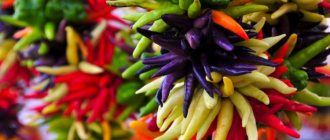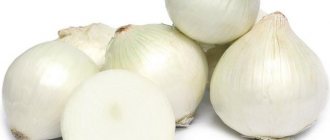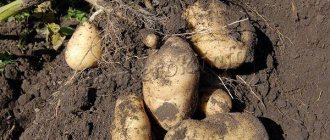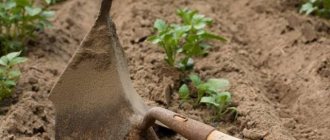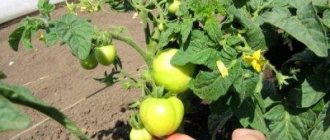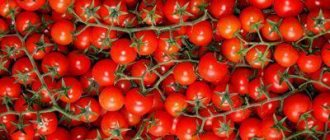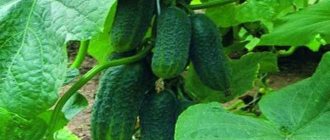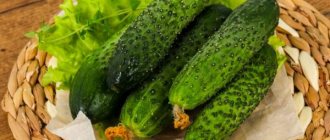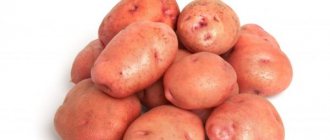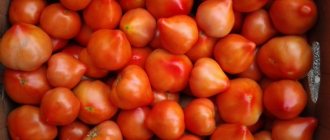Finishing the next summer season, I always take stock. What worked well this year and what didn’t work out. Based on this, I am drawing up a planting plan for next year. This year, of all the pepper varieties planted, the Gogoshary variety was especially successful. The article will discuss the characteristics of the Gogoshary variety, how to prepare for sowing, how to care for seedlings and plant them in the ground.
About Gogoshary pepper 2. Characteristics of the variety 3. Features of sowing 4. How to care for seedlings 5. Transshipment and planting of peppers 6. Dishes from Gogoshary
Photo: Gardeners love Gogoshary peppers.
History of the appearance of the variety
Sweet pepper Gogoshary (or Gogoshar) was bred in Moldova, namely at the Moldavian Research Institute of Vegetable Growing back in the 90s of the last century. From one successful variety, the research institute staff created a group with similar characteristics.
Often these peppers are called Ratunda. The varieties included in this group may differ in color; varieties with yellow and orange colors have been bred. In addition to sweet varieties, there are also semi-spicy ones. Another variety from this group, Kolobok, has proven itself well.
Important! Quite recently, the Novy Goshary pepper was bred - in its characteristics and description it is very close to the Gogoshary pepper. This is an improved variety, the fruits are larger and slightly elongated.
Pepper varieties
A group of varieties has similarities and differences. The choice of gardeners depends on what additional characteristics the variety has.
Ratunda
The most famous representative of the Gogoshary group is called Gogoshary or Ratunda. External characteristics of the fruit:
- The color of the pepper is always bright red;
- its shape resembles a small pumpkin;
- the taste of pepper is spicy, but there is no bitterness;
- the fruit weighs from 100 to 130 grams, the walls of the fruit are not thick, but dense.
See also
How can you distinguish seedlings of hot pepper from sweet pepper?
Read
Ruby
A special feature of this type is its ability to tolerate lower temperatures than other Gogoshary varieties.
The fruits are round, with pronounced ribs. Their color is dark red, almost brown, and they can weigh from 110 to 150 grams. The walls of the fruit are thick, reaching 10 millimeters.
Kolobok
Pepper is dark red in color. The shape of the fruit is round, flattened on both sides. Peppers of this variety can be picked light green; their taste characteristics will not differ from red ripe fruits.
Olenka
As they ripen, the color of peppers of this variety changes from dark green to brown. The vegetable has a round shape, with pronounced wrinkles. The average weight of the fruit reaches 100 grams.
Sweetie
The color of this variety can be yellow, green or red. The vegetable has the usual round shape, characteristic of the Gogoshary group. As it matures, it becomes cone-shaped. The walls do not thicken more than 7 millimeters.
Fragrant golden anniversary
The fruits of this variety are yellow in color and weigh up to 200 grams. The wall thickness varies from 8 to 10 millimeters. The vegetable is often used in assorted preparations; it is also suitable for freezing.
Golden Tamara
The color of the fruit is golden yellow, but during the period of technical ripeness it can be harvested green. The thickness of the walls reaches 10 millimeters, the average weight of the fruit is 180 grams.
Description of the Gogoshary pepper variety and its characteristics
Those gardeners who once tried to grow these peppers do not refuse them in the future. Here is a brief description of the Gagasharsky pepper variety (as Gogoshary is sometimes incorrectly called in common parlance, although it is the same thing).
- The bush is semi-spreading, standard, low, from 50 to 80 cm. The leaves are dark green with pointed tips.
- The fruits are small, shaped like a pumpkin or tomato, flattened and ribbed. The weight reaches 100-150 g, the wall is up to 1 cm thick. At technical ripeness, the color of the fruit is dark green, at biological ripeness it is red. The stalk is strong, so the fruits do not droop down, but look up.
- In terms of ripening speed, it is mid-season, from germination to harvesting 110-120 days, depending on weather conditions.
- Productivity up to 5 kg per square meter. m, in good conditions and up to 9 kg with strict adherence to all agricultural practices.
- The taste is rich, sweet, with hints of honey, no bitterness.
The thickness of the wall of Gogoshary pepper reaches 1 cm
Advantages and disadvantages
Among the advantages we note the following:
- Gives good harvests.
- The fruits are fleshy and juicy.
- Honeycomb has a pleasant honey taste with a slight bitterness.
- Can be stored for a long time.
- After harvesting, the fruits can ripen indoors.
- Resistance to transportation.
- Due to its low calorie content, it is suitable for dietary nutrition.
- Can be used for food both raw and cooked.
- The variety is suitable for conservation.
- The fruits have many beneficial properties.
Flaws:
- The Gogoshary variety does not like dry soil.
- Cannot tolerate lack of daylight.
- Requires regular fertilization.
- The plant has weak immunity to various diseases characteristic of nightshade crops (late blight), and is also attacked by pests.
- The stem is too brittle.
- A root that is close to the surface can be accidentally damaged.
By creating good conditions for growing Gogoshar peppers, you can provide yourself with a lot of vitamins throughout the winter. In addition, sweet peppers are an excellent remedy for the prevention of vascular diseases.
Pros and cons of the variety
The wide distribution of this variety is due to a number of undoubted advantages.
- High yield from one bush.
- Thick fleshy wall.
- Ability to ripen.
- Good transportability.
- Harmonious sweet taste.
- Convenient form for cooking, especially for stuffing.
At the same time, the variety also has disadvantages: it is susceptible to root rot, is affected by some pests, and likes abundant watering.
Technology of growing seedlings
You can grow good seedlings at home without buying them on the market, where it is easy to encounter unscrupulous sellers. What do I need to do? Agricultural technology is described step by step below.
Seed selection and preparation
It is better to buy planting material from trusted manufacturers, such as, for example, Aelita, in large gardening centers, or order from online stores with a good reputation.
Having opened a bag of seeds at home, you need to select the largest, lightest in color and without damage.
Now you need to disinfect them. To do this, place 3% chlorhexidine in a pharmaceutical solution for half an hour, then rinse with cold running water and soak in warm water for 2 hours. Next, place in a cloth or between two cotton pads for germination. You need to make sure that the discs do not dry out. They germinate in 5-6 days.
Important! Pepper seeds are considered difficult to germinate, especially if the manufacturer overdried them in preparation for storage, so they can take a long time to germinate—sometimes up to 3 weeks.
Planting seedlings
Sprouted seeds are sown in cups with good, loose soil. The optimal sowing depth is 1 cm.
How to plant?
Gogoshar varieties are easily cross-pollinated, so to obtain a clean harvest, the crop is planted away from other sweet and bitter peppers. Choose a site for growing vegetables that is well lit by the sun and protected from the wind.
Crop rotation plays an important role.
The crop grows well after the following vegetables:
- cabbage;
- beet;
- onion;
- carrot;
- cucumber.
To reduce the likelihood of infection with diseases characteristic of the nightshade family, peppers are not grown after potatoes and tomatoes.
Soil and seed preparation
To grow seedlings, purchase a substrate from a specialized store or prepare it yourself by mixing turf soil, peat and humus in a ratio of 2:2:1.
Sawdust or coarse sand is also added to the mixture. Peppers are grown in seedlings. Before sowing, allow the soil to warm up well. The soil must be disinfected by calcining it in the oven for 10-15 minutes or by watering it with a 1% solution of potassium permanganate.
The seeds are also disinfected by placing them in a 1% solution of potassium permanganate for 20-30 minutes and then rinsing them with clean water. For germination, seed material is wrapped in damp cotton cloth for 2-3 days.
As the gauze dries, the seeds are moistened. Sowing is done in moist soil. The soil is moistened with a sprayer. To create greenhouse conditions, the container with seeds is covered with glass or film.
The seedlings are placed on a warm, illuminated windowsill before being planted in a permanent place of growth.
For your information. Seedlings do not tolerate changes in location, temperature and light. Peppers are sown at the end of February.
Caring for peppers in open ground
After planting the seedlings, when the plants become stronger and begin to grow, it is necessary to provide them with good care. How can we do this better? Below is more information on cultivating the plant.
- How to water. Peppers are watered infrequently, but generously. Once a week you need to pour 2-3 liters of water under each bush. It is advisable that it be at least a little warmed up in the sun.
- Mulching. This technique, unfortunately, is not very common among gardeners, but its benefits are great. Materials for mulching can be found literally under your feet. This is grass cut between rows and placed under pepper bushes. You can use hay or straw, sunflower husks, etc. Mulch will protect the soil from overheating; if the temperature is high in summer, you can water the plants less often, because mulch retains moisture well.
- How to fertilize. For good development of the bushes, it is necessary to feed them with mineral fertilizers 3 times during the growing season. The first time is 2 weeks after planting with nitrogen-dominated fertilizers. The second is before flowering with a predominance of potassium and phosphorus. And the third time before pouring the fruits on the bushes with the same composition.
- Stepsonning and garter. The Gogoshar pepper has a low bush, so it needs to be planted with caution. Only the stepsons that grow before the first branch are broken off. The rest can be left so as not to reduce the yield.
Collection and storage
When the peppers turn red, they are ready to be harvested. They need to be removed from the bush and there will still be green ones left on it, which will gradually ripen. There may be several such waves of collection, it all depends on what the weather will be like. In the south, Gogoshar pepper can be harvested until mid-October.
The fruits can be stored in a cool room or in the refrigerator until the New Year in the department for vegetables and fruits. And if there is a cellar or basement, then the peppers should be placed in plastic boxes with holes, interlaced with clean paper.
In this case, it is not necessary to wait until the pepper turns red - you can collect green ones or those starting to turn red. Gogoshar pepper can ripen perfectly in a box without compromising its taste.
Ripening fruits of Gogoshary pepper
Diseases and pests
Varietal peppers, unlike hybrid ones, are more often affected by diseases. These are mainly fungal diseases, such as gray and white rot, late blight, cladosporiosis, fusarium, powdery mildew, etc. The roots of peppers can be affected by rot when watered with cold water.
Of the pests that attack peppers in open ground, the Colorado potato beetle is especially dangerous. Under favorable conditions, it can multiply greatly and cause great damage to pepper plantings. To prevent the spread of this pest, you do not need to plant peppers next to potatoes.
Among other pests, Gogoshar pepper can be affected by spider mites, aphids, mole crickets, and slugs.
Important! If there is a large infestation of aphids or Colorado potato beetles, it is advisable to use pesticides.
Reviews
- Germination is high, but the plant is demanding and sensitive to temperature changes. Disease prevention and regular pest control are required. Unusual taste - pepper adapts to nearby crops. It is worth planting in places after onions and carrots, cabbage, cucumbers and beets (Nikolai, Cheboksary).
- There is no need to wait for the harvest to turn red; green fruits are suitable for salads. Picked green, the pepper turns red after 3 weeks. Water with exclusively warm water and direct it to the root. The culture prefers a humid environment, so it is worth watering the paths between the rows in the greenhouse (Elena, Volgograd).
The manufacturer recommends growing pepper in the Central region of the country. For regions with cooler spring-summer periods, cultivation in greenhouse conditions is suitable.
